Tutorial 6: File Transfer and Sending Email Messages
Main Objectives of this Practice Tutorial
- List common utilities contained in the ssh application framework
- Securely copy files between Unix/Linux servers using the scp command
- Securely transfer copies of files between Unix/Linux servers using the sftp command
- Use the ssh command to run and view commands on a remote computer from a local computer.
- Use the mail command to send email with file attachments to your Seneca email account
Tutorial Reference Material
Course Slides:
Definitions:
File Transfer Commands:
Instructional Videos:
Key Concepts
The ssh Linux command is a suite of tools to allow the user to issue Linux commands securely between Unix / Linux servers, as well as securely copy and transfer files among Unix/Linux servers.
In this tutorial, you will learn several different methods to securely transfer files from your Matrix Linux account to other computers using Linux commands including scp, sftp and mail.
Issuing Commands on Remote Unix/Linux Servers
You can use the ssh command to issue Unix/Linux commands on a remote server from your local computer without logging into a remote server (such as Matrix).

The ssh command can be used to run and view commands on remote computer from a local computer.
Command Usage:
ssh username@matrix.senecacollege.ca 'ls -l'
You will be prompted for your Matrix account password, then the contents of your home directory in your remote Matrix account will be displayed on your local computer's terminal.
Secure Copy (scp)
The scp command is used to securely copy files between your local computer and remote Unix/Linux server. The usage for the scp command is similar to the cp command with the addition of user name and host name.
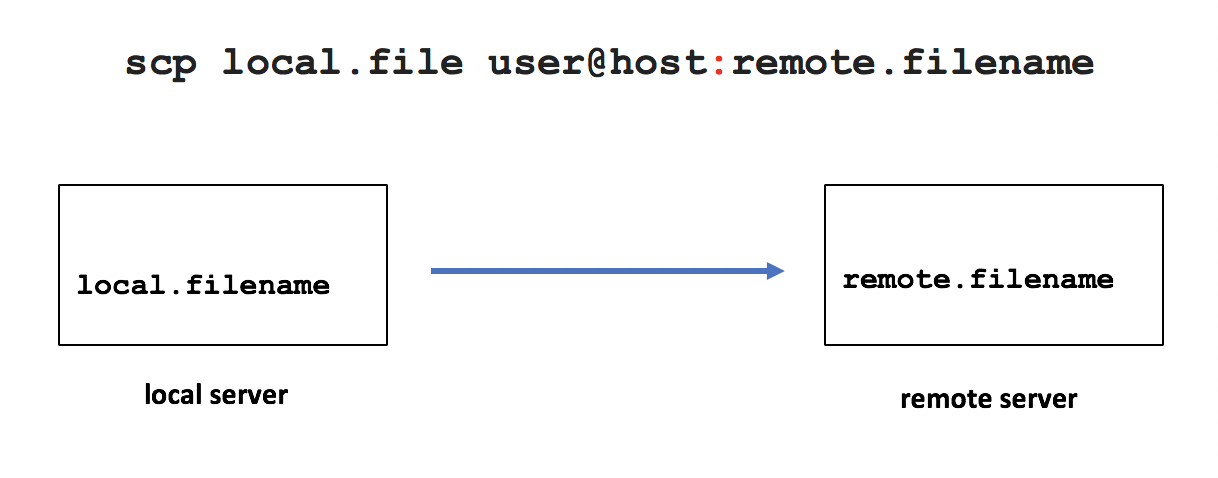
The scp Unix/Linux command is used to securely copy files between Unix/Linux servers.
Command Usage:
scp local.file username@host:destination-pathname
scp local.file username@host:
scp user@host:file-pathname local-pathname
The most common mistake that students make is forgetting to add the colon character ":" after the remote hostname.
The user name in the command can be omitted if it's the same as on the local host. Multiple file and recursive directory copy (i.e. option -r) is supported.
Secure File Transmission Control Protocol (sftp)
FTP stands for File Transfer Protocol which provides a set of rules on how to convert data that is transferred between computers (both identical and different operating systems). The sftp command performs file transfers securely using encryption.
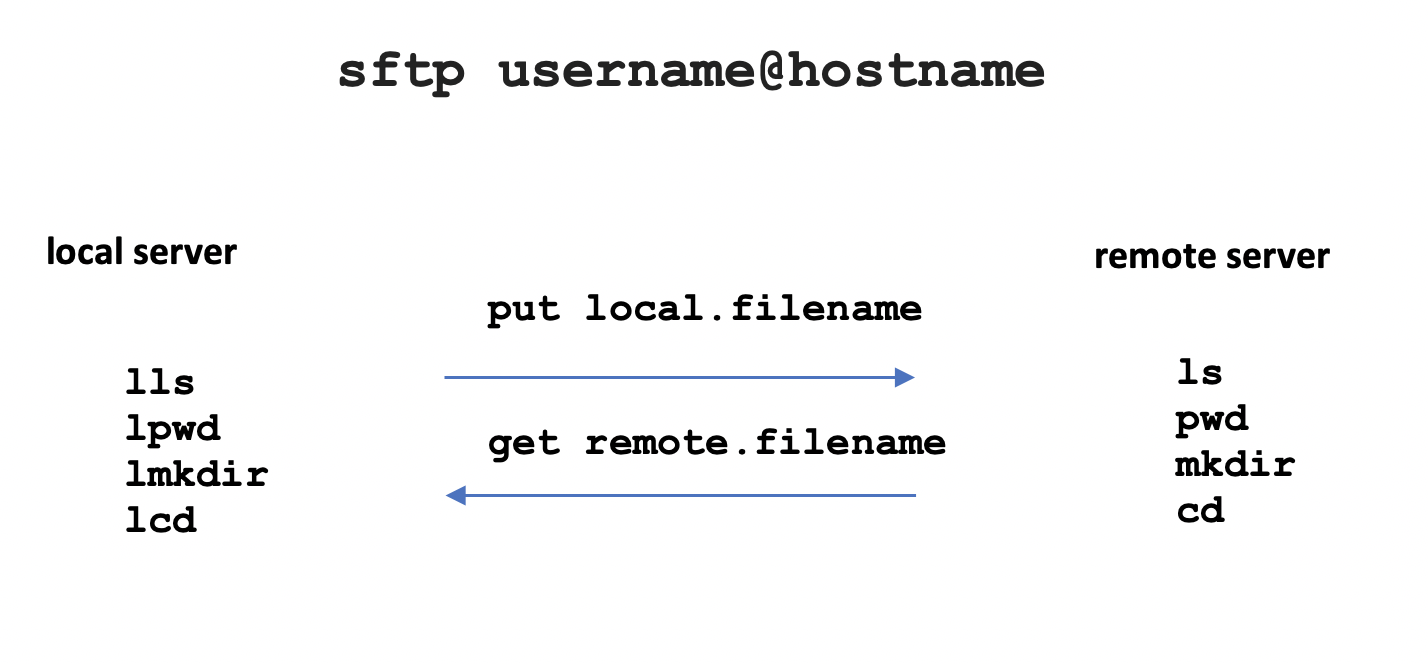
The sftp Unix/Linux command is used to securely transfer (copy) files between Unix/Linux servers.
Command Usage:
sftp username@hostname
When you login via the sftp command, the sftp prompt appears. The sftp prompt is like a Bash shell prompt, but with a limited number of commands. When issuing sftp commands, the local server relates to the server where you first issued the sftp command. Refer to the diagram on the right for local and remote sftp commands.
Graphical SFTP Applications
Although it is important to know how to use the sftp command for quizzes, midterm and final exam, there are graphical sftp applications that provide an alternative to issuing commands.
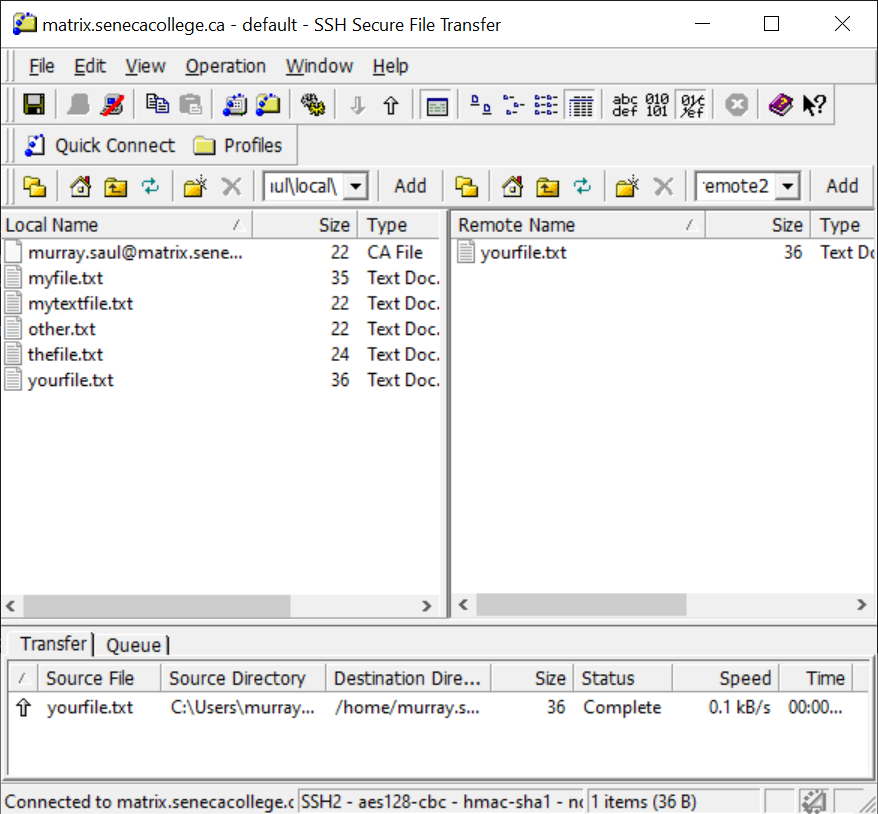
If you installed the graphical Secure Shell Client application in your Windows computer from performing TUTORIAL 1 INVESTIGATION 1, you can use this application to transfer files between your computer and your Matrix account by graphically navigating, selecting and dragging files between computers.
Sending Emails with File Attachment (mail)
You can use the mail command in Matrix to send email messages to other email accounts via the Internet.
Sending a Simple Email Message:
- Type: mail username@hostname and press ENTER
- Enter subject line and press ENTER
- Type the body of the message and then when finished, press ctrl+d to send message
Sending an Email Message with a File Attachment:
- Type: mail username@hostname -a filepathname and press ENTER
- Enter subject line and press ENTER
- Type the body of the message and then when finished, press ctrl+d to send message
Alternative Method of Sending an Email Message with a File Attachment:
- Type: mail -s "subject line" username@hostname < filepathname
- Press ENTER to send

NOTE: You would have to use this method since you have used stdin redirection to attach the file’s so you can’t input the subject line from the terminal!
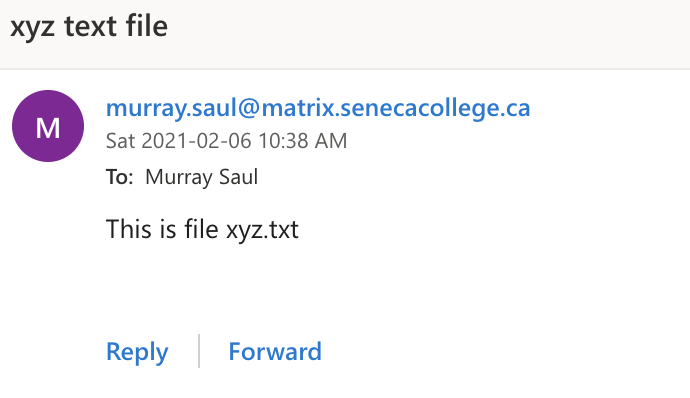
Viewing email with file attachment in Seneca email account.
Investigation 1: File Transfer (Secure Copy)
ATTENTION: This online tutorial will be required to be completed by Friday in week 8 by midnight to obtain a grade of 2% towards this course
The SSH package on your home computer and on the Matrix Linux server contain a suite (i.e. collection) of secure utilities including ssh and scp.
In this investigation, you will learn how to use the scp command to securely copy files between your computer and your Matrix Linux server. This methods is useful because it can be performed in the MS-Windows, MacOSx, and Unix/Linux operating systems.
You will also learn how to issue the ssh command to run commands on your remote Matrix server while remaining on your local computer.
Perform the Following Steps:
- Determine which operating system that your computer is using.
- Connect to your Matrix account using the instructions in the table below based on your current operating system.
Using Windows 10 (or above):
- From the start menu, type cmd and launch program
- In the command terminal, enter the following command:
ssh senecausername@matrix.senecacollege.ca
Using macOS:
- Click Launchpad icon, type terminal and press ENTER
- In the terminal, enter the following command:
ssh senecausername@matrix.senecacollege.ca
Using Linux:
- From the menu, choose: Applications > System Tools > Terminal
- In the terminal, enter the following command:
ssh senecausername@matrix.senecacollege.ca
- NOTE: Make certain to open a command-line terminal and NOT a graphical SSH application for this tutorial.
- After logging into your Matrix account, issue to the pwd command to confirm you are in your home directory.
- Issue the following Linux command to create the following directory:
mkdir ~/remote
- Change to the ~/remote directory and confirm that you have changed to that directory.
- Use a text editor to create a text file called myfile.txt
- Enter the following two lines displayed below in your editing session:
This is my file
It is a small file
Save editing changes to your myfile.txt file and exit your text editor.
Let's run a shell script to check that you created the remote directory and that you created the myfile.txt file (with correct file contents) in that directory.
- Enter the following command:
~uli101/week6-check-1
If you encounter errors, make corrections and then re-run the checking script until you receive a congratulations message, and proceed to the next step.
- NOTE: We will now learn to transfer files between your local home computer and your remote Matrix Linux server.
Exit your Matrix ssh session but remain in the command terminal on your local computer..
- ATTENTION: You are required to remain in your local computer's command terminal for the remainder of this INVESTIGATION and INVESTIGATION 2.
- The mkdir command works with MS Windows/UNIX/Linux/MacOSx computers. Issue the following command on your local computer to create a directory called local:
mkdir local
- The cd command works with MS Windows/UNIX/Linux/MacOSx computers. Issue the following command on your local computer to change to the local directory:
cd local
If you are using MS Windows on your local computer, issue the
dircommand to confirm you are in the local directory; otherwise, use thepwdcommand.If you are in MS Windows, open the GRAPHICAL
NotePadapplication to create a text file (Otherwise, use the nano or vi text editor).Enter a few lines of text, and if using Notepad, then click on the File menu and select save as (save as the filename
other.txtin yourlocaldirectory) and then exit the Notepad text editor.- NOTE: if using another text editor, save your editing session and exit the text editor.
If your OS is MS Windows issue the
dirWindows command to view the contents of your current directory (otherwise, issue thelscommand for other operating systems).- We will use the scp command to copy the local file called other.txt to your home directory on your remote Matrix Linux server.
Issue the following Linux command to copy the other.txt file from your local machine to your remote Matrix server (replace yoursenecaid is YOUR Seneca ID and ADD A COLON : TO THE END OF THE COMMAND):
scp other.txt yoursenecaid@matrix.senecacollege.ca:
When prompted, enter your Matrix password.
- TIP: You can issue the ssh command, followed by a command that will be run on your remote computer, but display on your local computer without having to establish a continuous connection to your remote Matrix server.
Issue the following command (using your matrix username):
ssh yoursenecaid@matrix.senecacollege.ca 'ls -l other.txt'
When prompted, enter your password and press ENTER.
- Do you see detailed information other.txt file? (look at bottom)
- That command was run remotely on your Matrix server as confirmation that you securely copied that file to the home directory of the Matrix server.
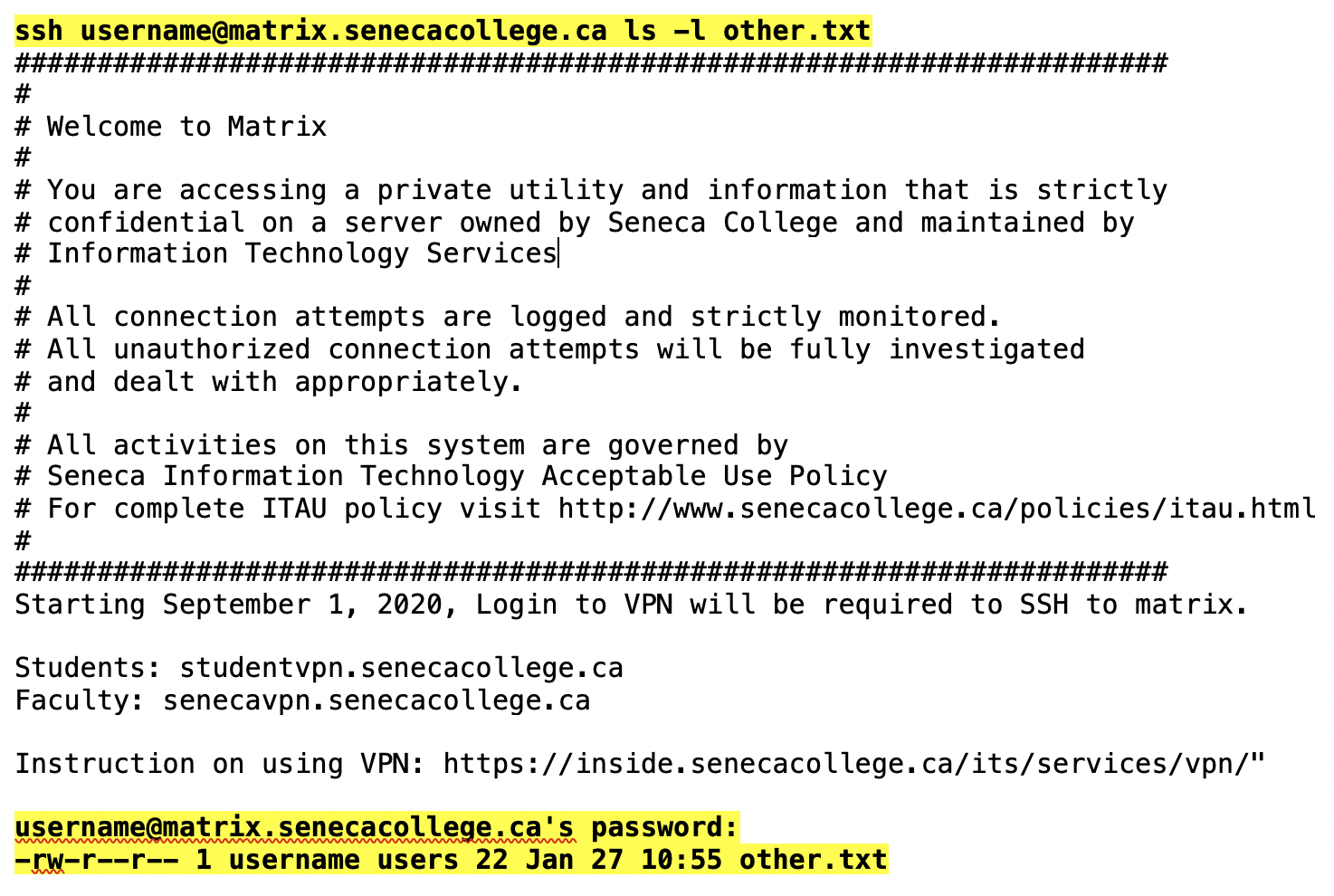
- Let's copy the file called myfile.txt in the ~/remote directory that you created earlier in your Matrix account to your local directory on your home computer.
- Issue the following Linux command (replace yoursenecaid is YOUR Seneca ID). The period "." as second argument represents your current directory on your local computer):
scp yoursenecaid@matrix.senecacollege.ca:remote/myfile.txt .
Issue the
dirorlscommand (depending on the OS of your local computer) to confirmed your properly copied that file from Matrix.Use the Notepad application (or vi for other OS types) to create a text file called
mytextfile.txt, type some text and then save in thelocaldirectory of your computer.Issue the dir or ls command (depending on your OS) to confirm that your newly-created file exists in your local directory.
We are going to intentionally make a mistake with the scp command.
- Issue the following Linux command to copy the mytextfile.txt file from your local machine to your remote Matrix server (replace yoursenecaid is YOUR Seneca ID and DO NOT INCLUDE THE : at the end of the command so see what happens):
scp mytextfile.txt yoursenecaid@matrix.senecacollege.ca
- Did you notice anything different (i.e. no password)?
- Issue the following command (using your matrix username):
ssh yoursenecaid@matrix.senecacollege.ca 'ls -l mytextfile.txt'
When prompted, enter your password and press ENTER.
- The file mytextfile.txt does NOT appear in your home directory on your Matrix server! Note that the COLON was NOT added to the end of the command! Therefore, you MUST remember to include the COLON : at the end of the hostname, or it will NOT remotely copy the file!
Issue the following command to properly copy that same file to your Matrix server:
scp mytextfile.txt yoursenecaid@matrix.senecacollege.ca:
- Issue the following command to confirm that it was remotely copied to your home directory in Matrix:
ssh yoursenecaid@matrix.senecacollege.ca 'ls -l /home/yoursenecaid/mytextfile.txt'
- Do you see the output for the detailed file listing of mytextfile.txt?
- What does this indicate?
- Issue the following command to copy the other.txt file on your local computer to the ~/remote directory in Matrix renaming it as different.txt:
scp other.txt yoursenecaid@matrix.senecacollege.ca:remote/different.txt
- Issue the following command to confirm that the file was remotely copied to your ~/remote directory in Matrix with a different filename:
ssh yoursenecaid@matrix.senecacollege.ca 'ls -l /home/yoursenecaid/remote/different.txt'
- Were you able to properly copy this file?
- Let's issue a checking script remotely to see that you properly copied that file from your local computer to your remote Linux server to both your home directory and ~/remote directory.
- Issue the following:
ssh yoursenecaid@matrix.senecacollege.ca '~uli101/week6-check-2'
- If you encounter errors, re-run the scp commands to correct and re-run the above command until you receive a congratulations message.
- Remain in the terminal on your local computer and proceed to INVESTIGATION 2.
In the next investigation, you will use the sftp Linux command to transfer (i.e. copy) files between your local computer and the Matrix server.
Investigation 2: File Transfer (Secure FTP)
The SSH package on your home computer and on the Matrix Linux server contain a suite (i.e. collection)of secure utilities including ssh and sftp.
In this investigation, you will learn how to use the sftp command to transfer files between Unix/Linux servers. This methods is useful because it can be performed in the MS-Windows, MacOSx, and Unix/Linux operating systems.
You will also learn how to issue the ssh command to run commands on your remote Matrix server while remaining on your localcomputer.
Command Line Terminal (CLI)
Let's look at using the sftp command on your local machine.
Perform the Following Steps:
- Make certain that you are in a command terminal on your local computer (i.e. do NOT log into your Matrix account).
- Issue a command (depending on your OS) to confirm that you are located in the local directory in your home computer.
If you are in MS Windows, open the
NotePadapplication to create a text file (otherwise: use another text editor like vi or nano)Enter a few lines of text, and then click on the File menu and select save as (save as the filename
thefile.txtin yourlocaldirectory) and then exit the Notepad text editor.- If you using another OS, then save-as using the same filename and directory location for the text editor you are using.
If your OS is MS Windows issue the
dirWindows command to view the contents of your current directory (otherwise, issue the ls command for other operating systems).- Note: the relative pathname symbols "." and ".." work for the Windows/MacOSx/Unix/Linux operating systems.
Issue the following command to move to the parent directory:
cd ..
- If your OS is MS Windows issue the
dirWindows command to view the contents of that parent directory that you changed to (otherwise, issue the ls command for other operating systems). - Issue the following command to start an sftp session (note: yoursenecaid is YOUR Seneca ID):
sftp yoursenecaid@matrix.senecacollege.ca
- NOTE: You may be required to enter yes to have the public key shared.
- You should be in the sftp command prompt where you are expected to issue sftp commands. Please take a moment to view common local and remote sftp commands on the table below.
| Operation | sftp Command (Local Server) | sftp Command (Remote Server) |
|---|---|---|
| Display current working directory | lpwd | pwd |
| Display directory contents | lls | ls |
| Create directory | lmkdir | mkdir |
| Change directory location | lcd | cd |
| Upload file to remote server | put | |
| Download file to local server | get |
- Issue the following sftp command:
pwd
- What is the pathname? Which server does this represent: local or remote?
- Issue the following sftp command:
lpwd
- What is the pathname? Which server does this represent: local or remote?
- Issue the following sftp command to create a directory on your remote server:
mkdir remote2
- Issue the following sftp command to confirm that the remote2 directory has been created in your remote server's home directory:
ls
- Issue the following sftp command to change to the remote2 directory on your remote server:
cd remote2
- Issue the pwd sftp command to confirm that you have changed to the remote2 directory on your remote server.
- Issue the following sftp command to change to the local directory on your local computer:
lcd local
- Issue the lpwd sftp command to confirm that you have changed to the local directory on your local computer.
- Issue the following sftp command to transfer the file called thefile.txt to the ~/remote2 directory on your remote server:
put thefile.txt
Issue the ls sftp command to confirmed that you transferred the file called: thefile.txt
- Let's create another directory on your local computer called local2 so we can learn to download a file from your remote directory.
Issue the following sftp command to change to the parent directory on your local computer:
lcd ..
Issue the lpwd sftp command to confirm that your current working directory on your local computer is your home directory.
Issue the following sftp command to create the following directory on your local computer:
lmkdir local2
- Issue the following sftp command to change to the local2 directory on your local computer:
lcd local2
Issue the lpwd sftp command to confirm you have changed to the local2 directory on your local computer.
- Let's learn to download a file from your remote server to your local computer.
Issue the following sftp command to transfer your thefile.txt file from the remote2 directory on your remote server to your local computer:
get thefile.txt
- Issue the lls sftp command to confirm that you transferred the file thefile.txt to your local computer.
- Issue the following sftp command to exit the sftp utlilty:
exit - Issue the following Linux command to remotely run a checking script to ensure you created the correct directories and properly transferred those created files:
ssh yoursenecaid@matrix.senecacollege.ca '~uli101/week6-check-3'
If you encounter errors, make corrections and then re-run the checking script until you receive a congratulations message.
- FYI: To run a checking program to check if you created the local and local2 directories in MS Windows would require running a local-based script (like PowerShell). Since this is a Unix/Linux based course, we don't have a PowerShell script, so we will ignore checking for files transferred to your local computer.
- In the next investigation, you will learn an alternative way to transfer a file to another computer server by sending an e-mail message with an attached file.
Investigation 3: File Transfer (Email)
The Matrix server is also an email server that can allow you to send emails messages to other email accounts.
In this investigation, you will learn how to transfer a file from your Matrix server to another computer by sending an email message with a file attachment.
Perform the Following Steps:
- Make certain that you connect and login to your Matrix server and confirm that you are located in your home directory.
- Issue the following Linux command (using your Seneca-ID):
mail yoursenecaid@myseneca.ca
- When prompted, enter the subject line:
Test Messageand pressENTER - In the email message BODY section, type the following text displayed below (and press ENTER):
This is a test email message
Press
ctrl-dto send your email message.- Did any output display? What you do think EOT stands for?
Launch a web-browser, login into your Seneca email account and check for new email messages. Did you receive the email message that you sent from your Matrix server?
- If you did NOT receive an e-mail message, check the JUNK or CLUTTER folders.
- If you still did not receive an email message, return to your terminal and re-issue the mail command making certain that you pressed
ctrl-dinstead of pressing ctrl-c
Return to your terminal (i.e. Linux Bash shell) and issue the following Linux command:
mail -a ~/remote/myfile.txt yoursenecaid@myseneca.ca
- When prompted, enter the subject line:
Test Message with Attachmentand pressENTER - In the email message BODY section, type the following text displayed below (and press ENTER):
This is a test email message with a file attachment
Press
ctrl-dto send your message.Switch to your Seneca email and check for new email messages.
- Did you receive that email message? Does the email contain a file attachment?
Return to your Linux Bash shell and issue the following Linux command:
mail yoursenecaid@myseneca.ca < ~/remote/myfile.txt
- What happened? Were you prompted for subject and could you enter text in email body?
- Did you see a file attachment as a separate file, or just text?
Check your email to see if you received your email message.
- You won't receive this e-mail. The mail command won't send messages without a subject line. Because you redirected that text file into mail, you weren't prompted for a subject line and the process silently failed.
- You can use the -s option, followed by text (in quotes) to specify a subject line.
Return to your Linux Bash shell and issue the following Linux command:
mail -s "email with attachment" yoursenecaid@myseneca.ca < ~/remote/myfile.txt
Check your email to see if you received your email message. If you did, what do you notice this time?
- As you've seen, redirecting a text file into mail causes the contents of that file to become the body of your message.
Let's combine all this together. First, create a new text file,
~/remote/body.txt, with the following content:This is the body text of my e-mail message saved in a text file.We're now going to combine the following options:
- -s: Subject line
- -a: Attach a file (~/remote/myfile.txt)
- Redirect the contents of a file to provide the body of the e-mail message. (~/remote/body.txt)
- Supply the destination e-mail address.
mail -s "Fully non-interactive e-mail with attachment." -a ~/remote/myfile.txt yoursenecaid@myseneca.ca < ~/remote/body.txt
Notice the order of options in the command's syntax. The destination e-mail address must be the last option before the redirect.
Check your inbox and confirm you've received this last message.
After completing this INVESTIGATION, perform the Linux Practice Questions section below.
Linux Practice Questions
The purpose of this section is to obtain extra practice to help with quizzes, your midterm, and your final exam.
Here is a link to the MS Word Document of ALL of the questions displayed below but with extra room to answer on the document to simulate a quiz: Week 6 Practice
Your instructor may take-up these questions during class. It is up to the student to attend classes in order to obtain the answers to the following questions. Your instructor will NOT provide these answers in any other form (eg. e-mail, etc).
Review Questions:
- Write a Linux command to copy a file in the current directory called mytext.txt from your Matrix account to your account called user1 on the Linux server domain name called tech.myserver.com to that user’s home directory.
- Write a Linux command similar to the previous question, but rename the file on the remote Linux server to yourtext.txt
- Write a Linux command to copy a file called ~/project/linux.txt to the remote server called linux.techie.org (your username for this remote server is the same username for your local server).
- Write a Linux command to connect to the username saulm for the server domain name tux.senecac.on.ca to transfer files between Linux servers.
- Assuming that you are connected to that server in question #4. What is the sftp command to display your current working directory on your local server?
- Assuming that you are connected to that server in question #4. What is the sftp command to view files in your local server? What is the sftp command to view files in your remote server?
- Assuming that you are connected to that server in question #4. What is the sftp command to download the file answers.txt from the current directory of your remote server?
- Assuming that you are connected to that server in question #4. What is the sftp command to upload the file questions.txt from your local server to the ~/documents/tests directory on your remote server?
- Assuming that you are connected to that server in question #4. What is the sftp command to quit your current session?
- Write a Linux command to send the attached file message.txt to the email address murray.saul@senecacollege.ca with the subject line: Important Message
- Create a table listing each Linux command, useful options and command purpose for the following Linux commands: scp , sftp , mail.
- Create a table listing each sftp command and it's purpose.
Author: Murray Saul
License: LGPL version 3 Link: https://www.gnu.org/licenses/lgpl.html